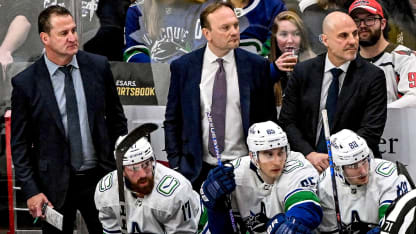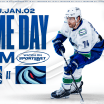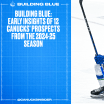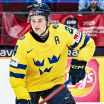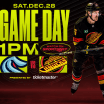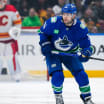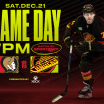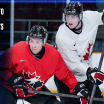Keeping the Vancouver Canucks’ players performing at their best takes more than a village – it demands an army.
In the spirit of teamwork, the length of this piece may rival the endurance of an overtime game, but fear not—it's all part of our science-based playbook. Just as the Canucks meticulously analyze plays on the ice, we've delved into the strategies employed by the team.
So, buckle up and get ready to explore the dynamic world of Vancouver Canucks' performance optimization, where every word is a well-coordinated play in the game of understanding and enhancing player potential.
-----
The Big Picture
Director of Sport Performance Alex Trinca, says it’s about getting a bird's eye view of the athlete from all the different coaches and practitioners and then diving down to a microscopic level in each category talking to the player themselves, coaching staff, analytics team, development staff and management group and the human performance team.
Through continuous communication at all levels, the human performance team can tweak holistic plans for each player with a focus on having them play and feel as good as possible.
Trinca said it’s empowering to work with Head Coach Rick Tocchet who believes in the value of the human performance team and working together. Tocchet says the importance of the human performance team is immeasurable to the team’s success.
“I think it's huge. I'm not an expert, so I rely on them, but having worked with Alex before and getting to know Mark [Cesari] they know what I like and how I like to practice so they get the guys workouts in before practice and what intensity it should be,” Tocchet said.
“I like when they come knock on my door and say ‘Okay Tocc, we need to know what you want to do’. I love that they're proactive with me to get the information to create plans.”
To figure out how to help players improve, Trinca and his staff look at the player on the ice, in the gym, treatment room, what they eat, sleep, and psychological readiness. They might check in with Yogi Svejkovsky on how a player’s biomechanics work, check in with Adam Foote to see if a player is making the right reads, for younger player development they consult Chris Higgins and also speak with mental performance consultant Alex Hodgins.
“When a performance problem arises, we just try and zoom out to consider all the different aspects of what’s contributing to the problem. It’s then about zooming in and zooming out of all those respective contributors to figure out how to generate the best plan to solve the problem which at all times requires multidisciplinary collaboration from people not just within the High Performance Team, but across the Hockey Operations Department,” Trinca said.
When looking at practice and travel times, the human performance team and Canucks coaching staff go through the schedule with a fine-tune comb, identifying tough stretches where they might have a bunch of games crammed together which they call “heat spots”. Earlier in the season, between October 15-25th the Canucks had seven games in 11 days, a mix of home and road games, and they have the same cadence between February 19-29th.
“They help the coaching staff determine the intensity of our practices and I think that's really important,” Tocchet said. “There are some other times where that heat graph is not as hot and we’ve got more days between games, a little more practice time, so you can get after the players a little bit more, whether it's in the gym or on the ice.”
Rest & Recovery
There’s a big focus on rest and recovery throughout the season, always trying to find situations and design scenarios like dimming the lights in the gym and locker rooms, removing blue light on cell phones, Normatec boots (recovery boots), electro muscle stimulation devices like firefly and PowerDot so players can unwind and rest after games.
“Sleep is ultimately a huge performance advantage for anybody that can figure out how to optimize it,” Trinca said. “Our players are oftentimes hyper aroused on stimulants: caffeine, ammonia inhalants, those types of things. We play a sport that's physically demanding not just from an exertion standpoint, but you get hit, so there's a certain ramification of that as well. Not to mention being under bright lights, loud noises and high intensity exercise late in the evening are all the antithesis of good sleep.”
After home games depending on the time of the game, there are expectations set out by the human performance team and thresholds that need to be met within a certain timeframe. It varies by workload during the game, but generally there’s 15-20 minutes of strength-oriented exercise as part of the post-game routine. A player that’s played 12 minutes on a third or fourth line defensive pairing might do more than a player who played 22 minutes on a first line. Conversely, if a player is used to playing 18 minutes and plays 22 minutes, their workout might get pushed to the next day or after the next game.
“Generally, a player's not going out there to prepare to play eight minutes, they prepare to play as much as they can,” Trinca explained. “So we have to find a way to merge that gap to help them feel like they emptied the tank, to allow them to potentially sleep a little better and have less anxiety. “You're always playing with the individual athlete and finding solutions that best fit their scenario.”
On the road, the human performance team gets creative, finding different ways for the players to cool down after games and try to get rest. The team doesn’t always have access to the same equipment they have at Rogers Arena and everyone is usually hustling to board the bus and then a plane less than an hour after the game is over.
Tempering the stress of altitude and pressure changes on flights to try and help the players be as comfortable as possible during travel is an important piece. The players use sleeping pads in certain areas of the plane to lay down, get extra sleep or stretch out, and they are encouraged to get up and walk around.
A 14-year NHL veteran, Ian Cole hasn’t mastered the art of falling asleep on a plane for the entire ride, but he catches a few z’s here and there.
“It's tough for me to sleep on a plane. If I'm tired, I'll sleep obviously, but there are some guys like as soon as the plane wheels up, they're out for four hours, which sounds unbelievable,” Cole said laughing.
The team has access to recovery boots which help decrease muscle soreness, inflammation and recovery time and pump lymphatic fluid from the legs to the central circulation system. There are also compression socks or gadgets that fit around the calf that cause the foot to move during flight to help circulate the blood.
“We’re trying to prevent pooling and increase the flow of fluid, especially after exercise,” Trinca said. “At home the guys are on the bike to cool down or get a massage, but because we're time constrained and on the plane at altitude we try to do everything we can to limit effects.”
Maintenance and Tune-ups
The treatment staff within the human performance team helps athletes by relieving any tightness in their body. The amount of work needed depends on the player’s style of play and what the stressors are. Massage techniques called “flushing” and tools like BFR (blood flow restriction, which helps circulate blood at a faster rate to remove waste like lactic acid) are used.
You’ll be able to find Conor Garland in the treatment room often which helps keep him limber when he takes the ice.
“It’s huge having such a great training staff, anytime I need a flush – I'm pretty high maintenance – Rebecca [White] and Roman [Kaszczij] are great with me and Alex and Mark are awesome too,” Garland said.
During his six years in the NHL, Garland says the technology has improved and he’s had good results using BFR. He also finds the less sitting around his hotel room he does the better he feels and getting out of his room keeps him fresh.
“As I've gotten older, I like walking with my wife and my dogs. I go for a long walk every day in Vancouver and I just incorporated that on the road. I get to explore cities and anytime we’re on the East Coast I’m with my parents and we go for walks.”
Cole knows his body and has his routine set for every game day. He comes in early and gets work done by one of the athletic therapists for around half an hour and then will get a flush or trigger point if needed post-game with the wellness therapist after his post-game workout.
“The best thing for me is rather than trying to get treatments done at random times is doing it consistently trying to stay in front of it. Based on schedule, I’m going pretty much every other day or every third day,” he said.
The Fuel
Strength and Conditioning Coach Mark Cesari has helped Trinca execute their nutrition plan, which includes getting recovery foods and smoothies ready after practices and games. As the game has evolved from the 90’s when Tocchet played, from a heavier game to a faster game, eating cheeseburgers and pizza after games is a thing of the past. Trinca says the to switch to a more sustainable strategy had to happen for modern-day players to have lengthy careers.
“We focus so much on physical activity, through practice and workouts, but I think we put a really important focus on our nutrition program, ensuring that our players have access to high quality nutrition products and supplements,” Trinca said.
Tocchet loves the emphasis placed on nutrition like the best food to eat before a game and managing player weight throughout the season, making sure they don’t lose too much or gain too much more than their optimal weight.
It’s possible that you’ve heard about Tom Brady’s TB12 Method, that sustained his 23-year career, and to continue to play at a high level, Cole switched up his diet five years ago eliminating gluten and dairy products.
“I took food sensitivity testing five years ago and I'm very mildly allergic to them, not to the point of getting sick if I eat it. I noticed a lot of inflammation when eating gluten and dairy and I just didn’t feel good, my joints started to ache, stuff like that, so I just cut them out and it's been way better,” he said.
The Marathon Continues
For the All-Star break the human performance team put together programs for each player based on what equipment they have access to, looking at their minutes played and any nagging problems they have. Some players don’t like to go more than two days without being on the ice and some need more of a break, but everybody was required to do something.
“That way we can actually maintain a little bit of stimulus and we don't have to take time to retrain again. We just maintain things so that they don't start to fall off,” Trinca said.
Trinca and Cesari sat down with Cole and customized a plan over the break that included cardio, sprints and lifting. He decided to take one or two days off but worked out the rest of the week at a moderate intensity to give himself a chance to recover from the first half of the season and stay ready for the second half.
With so much collaboration happening to help the athletes, it’s a testament to the buy-in of the group and everyone working with the same focus.
"The power in our entire organization lies within the multidisciplinary collaboration of all those different parties,” Trinca said. “We just try our best to put the right pieces of the puzzle in the right places and work together as a team to synthesize everyone’s expert understanding in different areas leveraging that into making the best decision we can for our team.”

